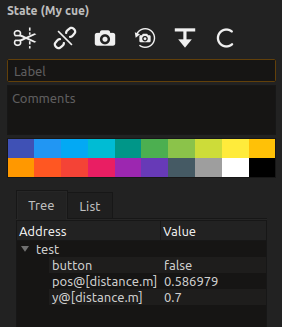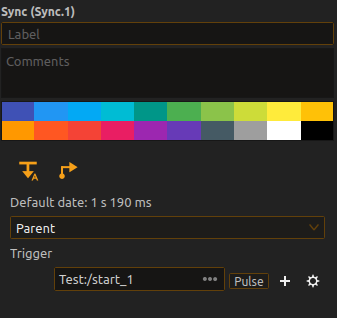Cues
Cues are an essential part of interactive shows: they allow to record a set of controls and messages that will be applied at a single point in time: OSC or DMX messages, MIDI control changes, etc.
In score, cues are messages that are contained inside states.
Creating a cue
Cues are created by drag’n’drop, from a set of Device explorer nodes, to the score.
It is possible to add messages to a cue by dropping on it. Existing messages to a given address will be replaced by the value that is being dropped.
Updating a cue
If you want to replace the parameters of a cue with their current value in the explorer, you can click on the state. The state inspector has a “Snapshot” feature which will update all the values stored in the cue, with their current live value.
- The first icon with the camera, “Snapshot” (Ctrl+L(Win / Linux) or⌘+L(Mac)), takes all the parameters currently selected in the Device explorer and copies them to the cue.
- The second icon, with the circled camera, “Refresh” (Ctrl+R(Win / Linux) or⌘+R(Mac)), takes all the parameters inside the saved cue, and updates them to their current “live” value as shown in the device explorer.

Playing a cue
Cues will be played automatically when the score execution reaches them:
Playing a cue manually
It is possible to play a cue through the “Play” tool in the user interface.
Playing a cue with an external control
It is possible to entirely control when a cue is going to be sent, by adding a trigger on it and let it “float” in the scenario.
Such a floating cue can originally be created by double-clicking on the scenario (or drag’n’dropping directly from the Device explorer, and removing the created interval afterwards).
Then, one needs to add a trigger (through the inspector or by pressing T when the state is selected), and configure it for out-of-time playback.
Here is how this would work:
The set-up on the triggers look like this:

Notice in particular that the two buttons, “Auto-Trigger” and “Start on play”, are checked.
It would be possible for instance to trigger the cue when a MIDI CC reaches a specific value or similar.
See Breaking the timeline for more information on triggers.